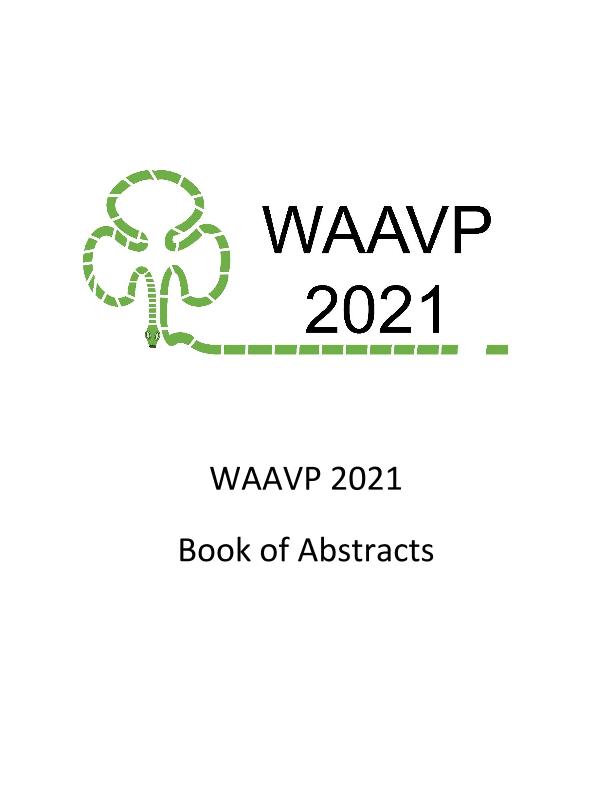Mostrar el registro sencillo del ítem
dc.contributor.author
Fuentes, Mariana Elisabet

dc.contributor.author
Lloberas, Maria Mercedes

dc.contributor.author
Luque, Sonia Elisabet

dc.contributor.author
Bernat, Gisele
dc.contributor.author
Riva, Eliana

dc.contributor.author
Fiel, Cesar Alberto

dc.contributor.author
Fernández, Alicia Silvina

dc.date.available
2022-04-27T17:13:40Z
dc.date.issued
2021
dc.identifier.citation
A comparison between two in vitro techniques to detect resistance to ivermectin in field populations of Cooperia spp. in cattle; 28th Conference of the World Association for the Advancement of Veterinary Parasitology; Irlanda; 2021; 1-2
dc.identifier.uri
http://hdl.handle.net/11336/155890
dc.description.abstract
Anthelmintic resistance in beef cattle production is a well-known worldwide problem, contributing to the economic losses caused by gastrointestinal nematodes. Resistance to ivermectin (IVM) is present in 93.5% of farms in Argentina, Cooperia spp. being the most prevalent genus (100%). Diagnosing AR under field conditions is currently done using the faecal egg count reduction test, which has been long used but lacks sensitivity to detect resistance in its early stages. In trying to improve this, in vitro techniques have been developed for different compounds and different parasites, and tested mainly in sheep parasites. As part of a large study on IVM-resistant populations of Cooperia spp. in beef farms, this assay was designed to evaluate two in vitro techniques, the micro-agar larval development test (MALDT) and the larval migration inhibition test (LMIT), on proven resistant (R) and susceptible (S) field populations. Both populations had been previously characterised by controlled-efficacy tests, showing that the efficacy of ivermectin against R and Se Cooperia was 66.3% and 99.5%, respectively. For the MALDT, eggs of both Cooperia isolates were exposed to twelve anthelmintic concentrations, from 4.7x10⁻¹⁰M to 2.18x10⁻¹¹M. The obtained EC50 values were: 6.93x10-9M (95%CI: 6.37x10⁻⁹M to 7.49x10⁻⁹M) for the R population and 8.33x10-10M (95%CI: 7.86x10⁻¹⁰M to 8.8x10⁻¹⁰M) for the S one, with correlation coefficients (R²) of 0.92 y 0.93, respectively; the resistance factor (RF) was 8.31. For the LMIT, ensheathed L3 were exposed to eight concentrations, from 10⁻⁵M a 5x10⁻⁹M. The EC50 values were 6.33x10-8M (95%CI: 5.30x10-8M to 7.49x10-8M) for the R population, and 8.03x10-8M (95%CI: 5.49x10-8M ? 1,19x10-7M) for the S population, with R² of 0.87 y 0.52, respectively; and a RF of 0.79. Based on these preliminary results, the MALDT would be a useful in vitro technique to detect field populations of IVM-resistant Cooperia nematodes.
dc.format
application/pdf
dc.language.iso
eng
dc.publisher
University College Dublin
dc.rights
info:eu-repo/semantics/openAccess
dc.rights.uri
https://creativecommons.org/licenses/by-nc-sa/2.5/ar/
dc.subject
IN VITRO TECHNIQUES
dc.subject
IVERMECTIN
dc.subject
RESISTANCE
dc.subject
COOPERIA
dc.subject
CATTLE
dc.subject
LARVAL DEVELOPMENT TEST
dc.subject
LARVAL MIGRATION INHIBITION TEST
dc.subject
GASTROINTESTINAL NEMATODES
dc.subject.classification
Ciencias Veterinarias

dc.subject.classification
Ciencias Veterinarias

dc.subject.classification
CIENCIAS AGRÍCOLAS

dc.subject.classification
Ganadería

dc.subject.classification
Producción Animal y Lechería

dc.subject.classification
CIENCIAS AGRÍCOLAS

dc.title
A comparison between two in vitro techniques to detect resistance to ivermectin in field populations of Cooperia spp. in cattle
dc.type
info:eu-repo/semantics/publishedVersion
dc.type
info:eu-repo/semantics/conferenceObject
dc.type
info:ar-repo/semantics/documento de conferencia
dc.date.updated
2022-04-07T17:18:38Z
dc.journal.pagination
1-2
dc.journal.pais
Irlanda

dc.journal.ciudad
Dublin
dc.description.fil
Fil: Fuentes, Mariana Elisabet. Consejo Nacional de Investigaciones Científicas y Técnicas. Centro Científico Tecnológico Conicet - Tandil. Centro de Investigación Veterinaria de Tandil. Universidad Nacional del Centro de la Provincia de Buenos Aires. Centro de Investigación Veterinaria de Tandil. Provincia de Buenos Aires. Gobernación. Comision de Investigaciones Científicas. Centro de Investigación Veterinaria de Tandil; Argentina
dc.description.fil
Fil: Lloberas, Maria Mercedes. Instituto Nacional de Tecnología Agropecuaria. Centro Regional Buenos Aires Sur. Estación Experimental Agropecuaria Balcarce; Argentina
dc.description.fil
Fil: Luque, Sonia Elisabet. Instituto Nacional de Tecnología Agropecuaria. Centro Regional Buenos Aires Sur. Estación Experimental Agropecuaria Balcarce; Argentina
dc.description.fil
Fil: Bernat, Gisele. Consejo Nacional de Investigaciones Científicas y Técnicas. Centro Científico Tecnológico Conicet - Tandil. Centro de Investigación Veterinaria de Tandil. Universidad Nacional del Centro de la Provincia de Buenos Aires. Centro de Investigación Veterinaria de Tandil. Provincia de Buenos Aires. Gobernación. Comision de Investigaciones Científicas. Centro de Investigación Veterinaria de Tandil; Argentina
dc.description.fil
Fil: Riva, Eliana. Consejo Nacional de Investigaciones Científicas y Técnicas. Centro Científico Tecnológico Conicet - Tandil. Centro de Investigación Veterinaria de Tandil. Universidad Nacional del Centro de la Provincia de Buenos Aires. Centro de Investigación Veterinaria de Tandil. Provincia de Buenos Aires. Gobernación. Comision de Investigaciones Científicas. Centro de Investigación Veterinaria de Tandil; Argentina
dc.description.fil
Fil: Fiel, Cesar Alberto. Consejo Nacional de Investigaciones Científicas y Técnicas. Centro Científico Tecnológico Conicet - Tandil. Centro de Investigación Veterinaria de Tandil. Universidad Nacional del Centro de la Provincia de Buenos Aires. Centro de Investigación Veterinaria de Tandil. Provincia de Buenos Aires. Gobernación. Comision de Investigaciones Científicas. Centro de Investigación Veterinaria de Tandil; Argentina
dc.description.fil
Fil: Fernández, Alicia Silvina. Consejo Nacional de Investigaciones Científicas y Técnicas. Centro Científico Tecnológico Conicet - Tandil. Centro de Investigación Veterinaria de Tandil. Universidad Nacional del Centro de la Provincia de Buenos Aires. Centro de Investigación Veterinaria de Tandil. Provincia de Buenos Aires. Gobernación. Comision de Investigaciones Científicas. Centro de Investigación Veterinaria de Tandil; Argentina
dc.relation.alternativeid
info:eu-repo/semantics/altIdentifier/url/http://www.waavp2021.com/wp-content/uploads/2021/08/WAAVP-2021-Abstract-book-22.07.21-FINAL.pdf
dc.relation.alternativeid
info:eu-repo/semantics/altIdentifier/url/http://www.waavp2021.com/
dc.conicet.rol
Autor

dc.conicet.rol
Autor

dc.conicet.rol
Autor

dc.conicet.rol
Autor

dc.conicet.rol
Autor

dc.conicet.rol
Autor

dc.conicet.rol
Autor

dc.coverage
Internacional
dc.type.subtype
Conferencia
dc.description.nombreEvento
28th Conference of the World Association for the Advancement of Veterinary Parasitology
dc.date.evento
2021-07-19
dc.description.paisEvento
Irlanda

dc.type.publicacion
Book
dc.description.institucionOrganizadora
University College Dublin
dc.description.institucionOrganizadora
Trinity College Dublin
dc.description.institucionOrganizadora
Queen’s University Belfast
dc.source.libro
Book of Abstracts: 28th Conference of the World Association for the Advancement of Veterinary Parasitology
dc.date.eventoHasta
2021-07-22
dc.type
Conferencia
Archivos asociados
